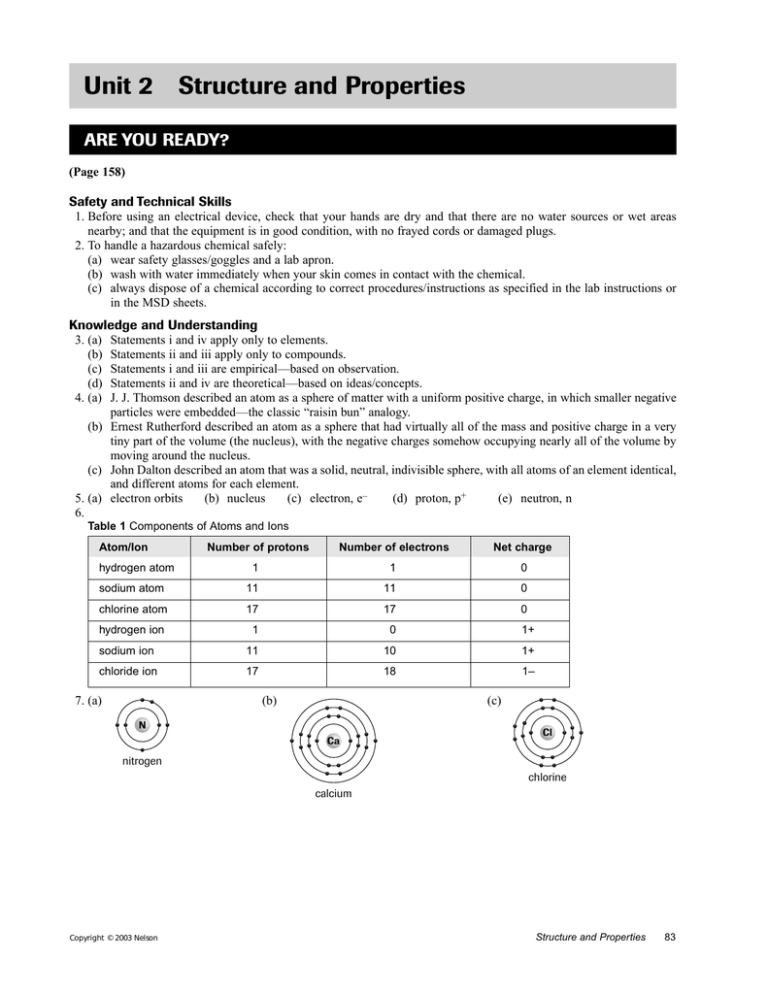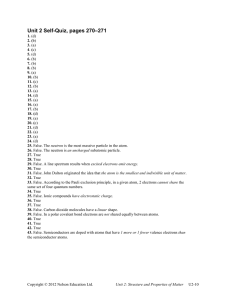Unit 2 Structure and Properties ARE YOU READY?
advertisement

Unit 2 Structure and Properties ARE YOU READY? (Page 158) Safety and Technical Skills 1. Before using an electrical device, check that your hands are dry and that there are no water sources or wet areas nearby; and that the equipment is in good condition, with no frayed cords or damaged plugs. 2. To handle a hazardous chemical safely: (a) wear safety glasses/goggles and a lab apron. (b) wash with water immediately when your skin comes in contact with the chemical. (c) always dispose of a chemical according to correct procedures/instructions as specified in the lab instructions or in the MSD sheets. Knowledge and Understanding 3. (a) Statements i and iv apply only to elements. (b) Statements ii and iii apply only to compounds. (c) Statements i and iii are empirical—based on observation. (d) Statements ii and iv are theoretical—based on ideas/concepts. 4. (a) J. J. Thomson described an atom as a sphere of matter with a uniform positive charge, in which smaller negative particles were embedded—the classic “raisin bun” analogy. (b) Ernest Rutherford described an atom as a sphere that had virtually all of the mass and positive charge in a very tiny part of the volume (the nucleus), with the negative charges somehow occupying nearly all of the volume by moving around the nucleus. (c) John Dalton described an atom that was a solid, neutral, indivisible sphere, with all atoms of an element identical, and different atoms for each element. 5. (a) electron orbits (b) nucleus (c) electron, e– (d) proton, p+ (e) neutron, n 6. Table 1 Components of Atoms and Ions Atom/Ion Number of protons Number of electrons Net charge 1 1 0 sodium atom 11 11 0 chlorine atom 17 17 0 hydrogen ion 1 0 1+ sodium ion 11 10 1+ chloride ion 17 18 1– hydrogen atom 7. (a) (b) (c) N Ca Cl nitrogen chlorine calcium Copyright © 2003 Nelson Structure and Properties 83 8. Table 2 Properties of Ionic and Molecular Compounds Properties Class of compound Classes of elements involved Melting point (high/low) State at SATP (s, l, g) Electrolytes (yes/no) ionic metals and nonmetals high s yes molecular nonmetals low s, l, or g no 9. (a) ionic (b) either (c) molecular 10. (a) 4 + Si F F F Si F F (b) + Ca 2 F F– Ca2+ F– 84 Unit 2 Copyright © 2003 Nelson (c) In (a), the rearrangement involves “sharing” of electrons by different atoms. In (b), the rearrangement involves loss of electrons by one atom, and gain of electrons by another. (d) All atoms attract electrons, but with very different strengths—depending on the atom’s structure. When the attraction (electronegativity) of two different atoms for electrons is very different in strength, electrons may be pulled completely away from one atom and held by another, creating positive and negative ions. Inquiry and Communication 11. A scientific law is empirical, based on observable “facts.” A scientific theory is theoretical, based on unobservable concepts. 12. Scientific laws usually precede scientific theories. Copyright © 2003 Nelson Structure and Properties 85




